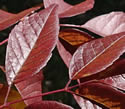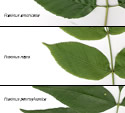Fraxinus americana (White Ash)
| Also known as: | |
|---|---|
| Genus: | Fraxinus |
| Family: | Oleaceae (Olive) |
| Life cycle: | perennial woody |
| Origin: | native |
| Habitat: | sun; mesic forest |
| Bloom season: | May |
| Plant height: | 50 to 100 feet |
| Wetland Indicator Status: | GP: FACU MW: FACU NCNE: FACU |
| MN county distribution (click map to enlarge): |  |
| National distribution (click map to enlarge): |  |
Pick an image for a larger view. See the glossary for icon descriptions.
Detailed Information
Flower: 

![[photo of male flowers]](/udata/r9ndp23q/pd3/fraxinus-americana-13-2-t.jpg) Flowers are borne on feathery panicles, several inches across, from leaf axils of one year old branchlets. Male and female flowers occur on separate trees, both lacking petals, the minute calyx in four parts, the male typically with just two, often red or purplish stamens, the female with only a single style. Flowers emerge before the leaves in spring.
Flowers are borne on feathery panicles, several inches across, from leaf axils of one year old branchlets. Male and female flowers occur on separate trees, both lacking petals, the minute calyx in four parts, the male typically with just two, often red or purplish stamens, the female with only a single style. Flowers emerge before the leaves in spring.
Leaves and bark: 

![[photo of leaf]](/udata/r9ndp23q/trees/Fraxinus-americana-front-t.jpg) Leaves are opposite and pinnately compound, 8 to 12 inches long with 5 to 9 (usually 7) oval to lance-elliptic leaflets. Leaflets are 2½ to 5 inches long and 1 to 2 inches wide with a distinct, ¼ to 1/3 inch, slender stalk, finely toothed edges, tapering to a pointed tip. The upper surface dark green and smooth, the lower surface pale green with short hairs along midvein and at the base of lateral veins.
Leaves are opposite and pinnately compound, 8 to 12 inches long with 5 to 9 (usually 7) oval to lance-elliptic leaflets. Leaflets are 2½ to 5 inches long and 1 to 2 inches wide with a distinct, ¼ to 1/3 inch, slender stalk, finely toothed edges, tapering to a pointed tip. The upper surface dark green and smooth, the lower surface pale green with short hairs along midvein and at the base of lateral veins.
![[photo of trunk]](/udata/r9ndp23q/pd3/fraxinus-americana-73489-2-t.jpg) Branchlets are often stout, smooth, green to brownish or even purplish colored with short, vertical white lenticels (pores) the first year. Branches turn brownish gray, the bark with blocky, diamond shaped ridges with deep furrows between them.
Branchlets are often stout, smooth, green to brownish or even purplish colored with short, vertical white lenticels (pores) the first year. Branches turn brownish gray, the bark with blocky, diamond shaped ridges with deep furrows between them.
Fruit: 
![[photo of fruit]](/udata/r9ndp23q/pd3/fraxinus-americana_015-t.jpg) Fruit is a single, spatula shaped, winged seed (samara), 1 to 1¾ inch long and ¼ to 1/3 inch wide, in open dangling clusters that can persist on the tree all winter.
Fruit is a single, spatula shaped, winged seed (samara), 1 to 1¾ inch long and ¼ to 1/3 inch wide, in open dangling clusters that can persist on the tree all winter.
Notes:
White Ash is a large forest tree that grows over 100 feet tall and 32 inches in diameter at breast height in mesic deciduous forests in Minnesota's southeast and east central counties, and is the largest and least common of our three native ash species. While all three species are very similar, White Ash can easily be distinguished from the other two by the distinctly stalked leaflets. It is also the only ash to develop a fall color that ranges from deep purple to bright red. In winter, the dormant buds most closely resemble Green Ash (Fraxinus pennsylvanica) with chocolate brown buds and the two lateral buds tight against the terminal bud, but the leaf scars of the lateral buds of White Ash are deeply crescent shaped and narrower. As an urban tree, it has been less frequently planted than cultivars of Green Ash, but like them, all the selected cultivars are males and so will rarely be observed with pistillate flowers or seeds in urban plantings. Unfortunately, it is highly susceptible to the destructive emerald ash borer to which it and all ash in North America will likely eventually succumb.
Native Plant Nurseries, Restoration and Landscaping Services ↓
More photos
 White Ash tree
White Ash tree White Ash in a residential landscape
White Ash in a residential landscape twig and crescent-shaped bud scar
twig and crescent-shaped bud scar crown branches
crown branches fall color
fall color fall color
fall color leaflet underside
leaflet underside more leaves
more leaves White, Black and Green Ash leaflet comparisons
White, Black and Green Ash leaflet comparisons White, Black and Green Ash terminal bud comparisons
White, Black and Green Ash terminal bud comparisons White, Black and Green Ash leaf scar comparisons
White, Black and Green Ash leaf scar comparisons
Photos courtesy Peter M. Dziuk taken in Ramsey County.
Comments
Have you seen this plant in Minnesota, or have any other comments about it?
on: 2018-12-16 16:31:08
A few years ago I found some wild plants in St. Louis County near Ely's Peak and Bardon Peak. What first gave them away was their red to purplish fall color. I returned again a couple of years later and noticed seedlings with the same leaflet stalk length.






